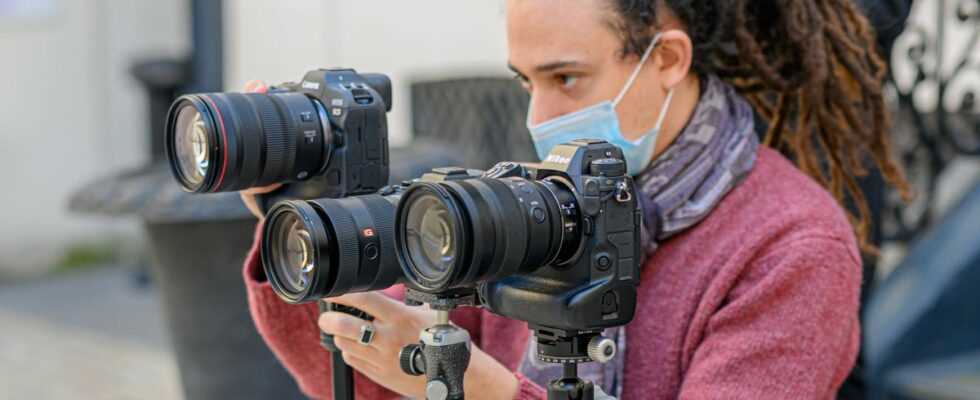4
The Nikon Z9 is a one-piece mirrorless camera for those who want to capture action. It is thus equipped with a latest generation autofocus system. We therefore wanted to put it to the test against its direct rivals, the Canon EOS R3 and Sony Alpha 1 (A1).
Nikon Z9
 Fnac.com
Fnac.com5,999.00
 Miss Digital
Miss Digital5,999.00
 Digit-photo.com
Digit-photo.com5,999.00
How the pricing table works
Canon EOS-R3


 Fnac.com
Fnac.com5,999.00
 Miss Digital
Miss Digital5,999.00
 Digit-photo.com
Digit-photo.com5,999.00
How the pricing table works
For a few years now, the autofocus of mirrorless cameras has surpassed that of reflex cameras. Recognition and tracking of many subjects (humans, vehicles or animals), very high speed bursts, both in photos and in video… In this market, hybrids intended for sports photographers, journalists or wildlife shoot everyone towards the top.
The three beasts on the test bench
Also, after Sony and its Alpha 9 (A9), A9 II and especially the Alpha 1 (A1), Canon launched with the imposing EOS R3, Nikon having meanwhile decided to release its “machine of war”, the Z9. The three devices therefore have all the aforementioned characteristics and we had to compare their performance in terms of responsiveness during our laboratory tests. The various measurements were taken with the 24-70 mm f/2.8 zoom lenses from each manufacturer.
A Z9 that wakes up quickly
Very fast devices.
Right off the bat, what sets the Z9 apart from its competitors is its quick wake-up. Protective curtain down or not, the Nikon comes out of its torpor in just over half a second, a real good performance. Especially when compared to its rivals. Thus, with the A1 – and this is classic with Sony devices – you have to wait a good second. With the EOS R3, and this is quite surprising for a Canon, the curtain up takes more than a second and a half. Quite a long wait for a device of this type.
A rocket by day, quieter by night
The Z9 continues its momentum by offering a truly excellent daytime focus. It therefore stands out as one of the very best devices in our comparison in this area. Opposite, however, the A1 and the R3 box almost in the same category by offering a slightly slower capture. We are here in the register of the imperceptible.
In low light, however, the Nikon plummets and is the slowest of the three devices. If the difference with the Sony A1 is negligible, the Canon EOS R3 shows a rare consistency with a performance at night almost similar to that of day. Finally, it is especially with the sequence of images (daytime) that the Nikon Z9 does well. Whereas the competition has to deal with a certain latency between shots.
“Only” 20 fps in classic burst, but…
When switching to burst mode, the Nikon Z9 cannot exceed 20 fps, while its competitors go up to 30 fps. Nikon does not hide it and had claimed this difference. However, it is possible to blast, and even vaporize this limitation. For that, it will however be necessary to do without recording in Raw. Thus, only in jpeg, it is possible to reach 30 fps, and always with autofocus tracking.
Nikon offers a lower maximum burst than its competitors.
… 120 fps in 11 megapixel jpeg
In addition, a mode at 120 fps (with tracking) in jpeg exists. The maximum definition then goes to 11 megapixels, against 45 by default. In this mode, the Z9 even reached 125 fps in our lab! Admittedly, the image clearly loses quality and the editing of the files is much more limited, but being able to count on such a burst with autofocus tracking is quite mind-boggling. So much so that we would like to find such functionality in the Sony Alpha 1 (A1) and the Canon EOS R3.
Above is an assembly of a burst of 300 shots taken in 120 fps and 11 megapixel mode. It is possible to completely break down an action. And with the tracking function, it is possible to select any image and see the right focus.
Conclusion: a success
Thus, as we have seen, the performance of the Nikon Z9 is more than respectable. It is in the top 3 of the best hybrid cameras in terms of responsiveness and does not fear many people. We can always regret a slower acquisition in low light, but nothing prohibitive. Its “classic” burst is less impressive than that of its rivals, although 20 fps is an excellent characteristic. And it makes up for it by offering faster modes – only in jpeg – without losing its autofocus tracking.
